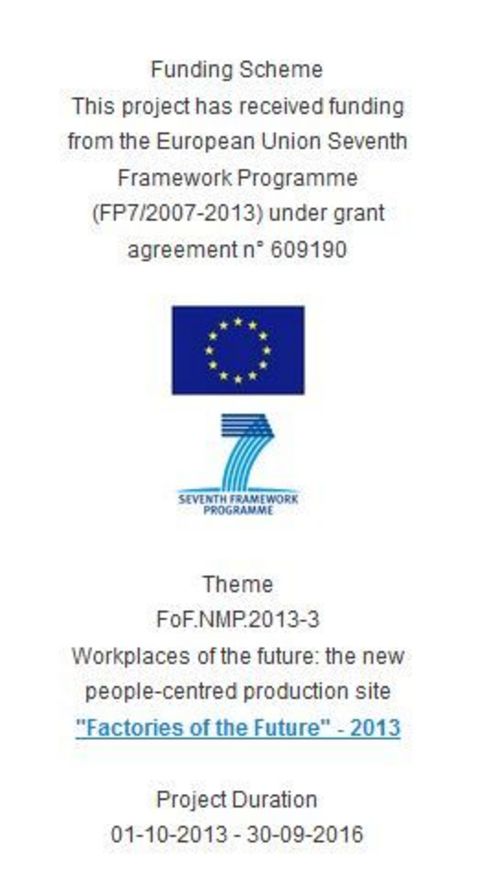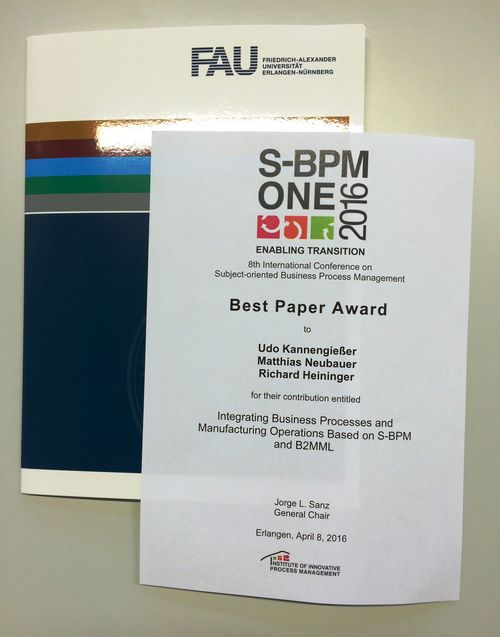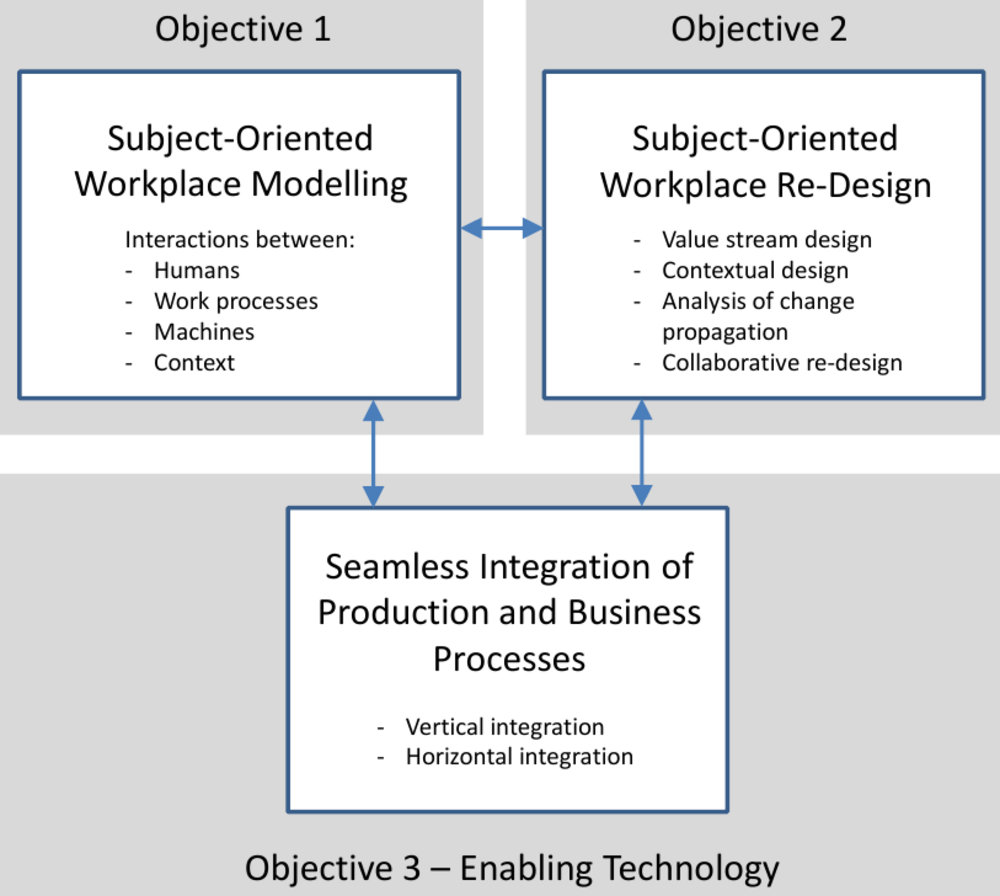Subject-oriented modelling, through its focus on interactions, allows better adaptation of machines, processes and context to the human worker. This Objective includes augmenting the coverage of subject-oriented modelling to explicitly represent interactions with machines and context, and subsequent implementation and evaluation through a case study. This case study will address a scenario similar to the one shown in Figure 1, involving flexible job assignments through communication between workers and machines. This case study will be implemented on the shopfloor at TC Contact. This Objective relates to increasing decision autonomy and motivation of workers.
Introduction
European production companies face a variety of challenges arising from the increasingly complex and dynamic environment in which they operate. These challenges have been understood mostly in economic terms based on the time-cost-quality triangle. The main approach to tackling these challenges has been to rationalise production processes through standardised work procedures and automated systems, aiming to reduce cost and increase productivity. However, the predominant focus on functionality and efficiency neglects a critical factor for sustainable organisational success: the human being. While worker satisfaction, motivation and empowerment have been recognised as critical for healthy production organisations, these human factors are often viewed at odds with the economic goals of a company. The goal of SO-PC-Pro is to develop methods and tools for holistic design and management of workplaces in production companies, thereby aligning business goals and human needs. It is based on a view of production companies as complex, socio-technical systems of people, processes and machines that flexibly interact. This view is well captured in the “subject-oriented” methodology for bpm. SO-PC-Pro will apply this methodology for the first time to modelling processes and interactions in the production domain, resulting in a new set of ICT-based technologies that will support people-centred workplaces in three ways. (1) through developing new human-machine interactions that allow for higher degrees of autonomy of workers, (2) through empowering workers to re-design their own workplaces using intuitive design methods and collaborative tools, and (3) through seamlessly integrating production and business processes to enable more adaptable workplaces throughout the whole enterprise. By building on existing models and interface standards, the technologies and case studies developed will demonstrate that people-centred production sites can be created in a not so distant future.

 SO-PC-Pro received Best Paper Award
SO-PC-Pro received Best Paper Award
Objectives
This Objective includes developing subject-oriented methods for workplace re-design
according to business and human values, borrowing from and extending methods for value stream design (VSD), contextual design, analysis of change propagation, and wiki-based re-design collaboration. The methods will be usable by those with the deepest insight into human needs at work: the workers themselves. The methods and tools developed will be implemented and evaluated through a case study at Fimap. This Objective relates to the workers’ empowerment by involving them in the responsible development of their workplaces, and the stimulation of teamwork.
This Objective targets the development of enabling technologies through seamlessly integrating production and business processes across all levels of control. It is based on the subject-oriented modelling approach establishing a uniform representation for control systems in any area of application. Existing industry standards, including OPC UA (IEC 62541), will be used for implementing the interfaces between subject-oriented models and the specific control systems including human and environmental sensor data. In addition, Metasonic’s workflow engine will be extended to provide the necessary real-time support for production control. For creating an integration solution ready to be evaluated in a real shopfloor environment, the development effort required would be too large for the scope of this project.
Therefore, the technologies developed for this Objective will be preliminary only, and will be developed and tested in a laboratory setting within JKU’s premises involving student volunteers. This Objective addresses a cross-thematic topic of NMP and ICT themes in the Work Programme 2013 (p. 43): the development of enabling technologies for adaptable machines and industrial processes. This also supports Objectives 1 and 2, as the implementation of enhanced workplaces can be directly mapped onto changes in real time production processes.
 Objectives
Objectives
Workpackages
The objective of WP1 is the smooth implementation of the project through appropriate mechanisms for management and coordination of other work packages and activities. It will address project infrastructure (committees, boards, quality plan, procedures, risk, registers, project management tools, internal web site, etc.) and financial and contractual management of the consortium, including maintenance of the Consortium Agreement, follow-up of contractual obligations (contractual reporting, deliverable issuing, monitoring of resources, communications with the Commission, etc.).
The scientific coordination of the project is not included in this WP. This WP only covers financial and administrative management/coordination activities. In accordance with article II.16 of the grant agreement, the efforts and costs related to the scientific coordination of the project are not included in this WP and will not be reported as management, but as RTD activities.
The objective of WP2 is the elicitation and analysis of requirements for the technologies to be developed, with respect to particular use cases. The use cases will demonstrate the applicability of the technologies with respect to 2 areas: “process automation”, and “empowering workers in assembly lines”.
The objective of WP3 is the development of methods and tools related to the 3 areas in which subject-orientation needs to be extended: (1) increasing the coverage of subject-oriented workplace models to include machines and context, (2) specialising the subject-oriented approach to analysis and improvement of workplaces for the production domain, and (3) providing semi-automated support for reconciling subject-oriented workplace models.
In addition, WP3 will develop and test the foundations for a seamless integration of production and business processes, as stated in Objective 3.
The objective of WP4 is the organisational and technical implementation and use of the technologies developed in WP3, within the use cases defined in WP2.
A use case called “Process Automation” will be implemented at TC Contact according to the definitions and specifications produced in WP2. It will include all the developed tools and methods of SO-PC-Pro. Factory-level tool installation equals in both companies.
The objective of WP5 is the organisational and technical implementation and use of the technologies developed in WP3, within the use cases defined in WP2.
A use case called “Empowered Workplace Improvement” will be implemented at Fimap according to the definitions and specifications produced in WP2. It will include all the developed tools and methods of SO-PC-Pro.
The objective of WP6 is the organisational and technical implementation and use of the technologies developed in WP3, within the use cases defined in WP2. A use case called “Mexico” will be implemented at BIMBO according to the definitions and specifications produced in WP2.
The objective of WP7 is the development of an evaluation framework providing data collection methods and tools and analysis methods for the formative as well as summative evaluations. The formative evaluation provides ongoing feedback for the development in WP3 of the SO-PC-Pro methods and tools (sensors and software components) to ensure the wearability and usability of the system.
The summative evaluation is based on the evaluation framework in line with the two case studies in WP4 and WP5 evaluating the SO-PC-Pro system to verify the objectives of the project.
The privacy of all workers will be respected at any time, and all data will be protected and anonymised. The data protection officers of the facilities involved will be informed to ensure that all requirements are met, and they will approve the data collection procedures.
The objective of WP8 is the management and effective use of the results of the project, in terms of dissemination and exploitation. In detail, it aims at:
• Creating awareness about the SO-PC-Pro project as well as about its objectives, progress and results within the targeted industrial sector and the scientific community
• Ensuring and promoting the exploitation of the results by production companies and by new potential end users
• Managing the acquired knowledge, competencies and outcomes to facilitate exploitation by potential end-users
Scientific Publications
Predictive Monitoring of Business Processes
Authors: Fabrizio Maria Maggi,Chiara Di Francescomarino,Marlon Dumas,Chiara Ghidini
Proceeedings: Proceedeings of CAiSE
Publication Date: 2014-06-16
Publisher: Springer
Subject-oriented process design across organizational control layers
Authors: Matthias Neubauer,Christian Stary,Florian Krenn
Proceeedings: 2014 12th IEEE International Conference on Industrial Informatics (INDIN)
Publication Date: 2014-06-27
Publisher: IEEE
Link: http://dx.doi.org/10.1109/INDIN.2014.6945549, öffnet eine externe URL in einem neuen Fenster
Generating Subject-Oriented Process Models from Ad-Hoc Interactions of Cognitive Agents
Authors: Udo Kannengiesser, Markus Radmayr, Richard Heininger, Nils meyer
Proceeedings: 2014 IEEE/WIC/ACM International Joint Conferences on Web Intelligence (WI) and Intelligent Agent Technologies (IAT)
Publication Date: 2014-08-11
Publisher: IEEE
Subject-Oriented Employee Involvement and Empowerment in Organizational Innovation
Authors: Florian Krenn, Matthias Neubauer
Proceeedings: Proceedings of the 2014 European Conference on Cognitive Ergonomics
Publication Date: 2014-09-03
Publisher: ACM Press
Link: http://dl.acm.org/citation.cfm?id=2637269, öffnet eine externe URL in einem neuen Fenster
The Role of Semantic Annotations in Business Process Modelling
Authors: Chiara Di Francescomarino, Marco Rospocher, Chiara Ghidini, Andrea Valerio
Proceeedings: 2014 IEEE 18th International Enterprise Distributed Object Computing Conference
Publication Date: 2014-09-05
Publisher: IEEE
Link: http://dx.doi.org/10.1109/EDOC.2014.33, öffnet eine externe URL in einem neuen Fenster
A Multi-Objective Approach to Business Process Repair
Authors: Chiara Di Francescomarino, Roberto Tiella, Chiara Ghidini, and Paolo Tonella
Proceeedings: ISOC 2014, 12th International Conference on Service-Oriented Computing
Publisher: Springer
Link: http://dx.doi.org/10.1007/978-3-662-45391-9_3, öffnet eine externe URL in einem neuen Fenster
Designing and Executing Interoperable IoT Manufacturing Systems
Authors: Udo Kannengiesser, Georg Weichhart
Proceeedings: Workshop on IoT Interoperability for Manufacturing @ 7th International Conference on Interoperability for Enterprise Systems and Applications, 24 March 2014, Albi, France.
Publisher: John Wiley & Sons, Inc.
Link: http://dx.doi.org/10.1002/9781119081418.ch2, öffnet eine externe URL in einem neuen Fenster
An Interactional View of Context in Business Processes
Authors: Udo Kannengiesser, Alexander Totter, David Bonaldi
Proceeedings: S-BPM One 2014
Publisher: Springer
Link: http://dx.doi.org/10.1007/978-3-319-06191-7_3, öffnet eine externe URL in einem neuen Fenster
Supporting Value Stream Design Using S-BPM
Authors: Udo Kannengiesser
Proceeedings: S-BPM One 2014
Publisher: Springer
Link:http://dx.doi.org/10.1007/978-3-319-06065-1_11, öffnet eine externe URL in einem neuen Fenster
Towards an Architecture for Human-aware Modeling and Execution of Production Processes
Authors: Matthias Neubauer, Florian Krenn,Dennis Majoe
Proceeedings: IFAC-PapersOnLine,Volume 48, Issue 3, Pages 294–299
Publication Date: 2015
Publisher: Science Direct
Link: http://dx.doi.org/10.1016/j.ifacol.2015.06.097, öffnet eine externe URL in einem neuen Fenster
Towards context-aware processes in people-centered factories of the future
Authors: Udo Kannengiesser, Matthias Neubauer, Florian Krenn, Chiara Di Francescomarino, Dennis Majoe, David Bonaldi
Proceeedings: Proceedings of the 7th International Conference on Subject-Oriented Business Process Management – S-BPM ONE ’15
Publication Date: 2015
Publisher:ACM Digital Library
Link: http://dx.doi.org/10.1145/2723839.2723858, öffnet eine externe URL in einem neuen Fenster
Complex Symbolic Sequence Encodings for Predictive Monitoring of Business Processes
Authors: Leontjeva Anna, Conforti Raffaele, Chiara Di Francescomarino, Marlon Dumas, Fabrizio Maria Maggi
Proceeedings: 13th International Conference, BPM 2015, Innsbruck, Austria, August 31 — September 3, 2015, Proceedings
Publication Date: 2015
Publisher: Springer International Publishing
Link: http://dx.doi.org/10.1007/978-3-319-23063-4_21, öffnet eine externe URL in einem neuen Fenster
OPC UA Interface for a BPM Suite to Enable Seamless Process Management
Authors: Udo Kannengiesser, Matthias Neubauer, Richard Heininger
Proceeedings: Proceedings of the BPM Demo Session 2015 Co-located with the 13th International Conference on Business Process Management (BPM 2015)
Publication Date: 2015
Publisher: CEUR Workshop Proceedings
Link: http://ceur-ws.org/Vol-1418/, öffnet eine externe URL in einem neuen Fenster
Collaborative Subject-oriented Workplace Re-design
Authors: Chiara Di Francescomarino, Mauro Dragoni, Chiara Ghidini, Richard Heininger,Udo Kannengiesser, Matthias Neubauer
Proceeedings: Proceedings of the BPM Demo Session 2015 Co-located with the 13th International Conference on Business Process Management (BPM 2015)
Publication Date: 2015
Publisher: CEUR Workshop Proceedings
Link: http://ceur-ws.org/Vol-1418/, öffnet eine externe URL in einem neuen Fenster
Worker-Driven Improvement of Processes in Smart Factories
Authors: Udo Kannengiesser, Matthias Neubauer, Chiara Di Francescomarino, Mauro Dragoni, Chiara Ghidini, Richard Heininger
Accepted at: Mensch und Computer 2015 – Workshop on Smart Factories: Mitarbeiter-zentrierte Informationssysteme für die Zusammenarbeit der Zukunft
S-BPM as the Glue for Integrating Enterprise Processes in Smart Factories
Authors: Udo Kannengiesser, Matthias Neubauer, Richard Heininger
Accepted at: On the Move to Meaningful Internet Systems: OTM 2015 Workshops
Publisher: Springer
Link: http://dx.doi.org/10.1007/978-3-319-26138-6_11, öffnet eine externe URL in einem neuen Fenster
Completing Workflow Traces Using Action Languages
Authors: Chiara Di Francescomarino, Chiara Ghidini, Sergio Tessaris, Itzel Vázquez Sandoval
Accepted at: CAiSE 2015
Publisher: Springer
Link: http://dx.doi.org/10.1007/978-3-319-19069-3_20, öffnet eine externe URL in einem neuen Fenster
Integrating cross-organisational business processes based on a combined S-BPM/DSM approach
Authors: Udo Kannengiesser
Accepted at: 2nd Workshop on Cross-Organizational and Cross-Company BPM
Publisher: Proceedings of 2nd Workshop on Cross-Organizational and Cross-Company BPM co-located with the 17th IEEE International Conference on Business Informatics (IEEE CBI 2015)
Link: http://ceur-ws.org/Vol-1408/, öffnet eine externe URL in einem neuen Fenster
Agents implementing subject behaviour: A manufacturing scenario
Author: Udo Kannengiesser
Publisher: Fleischmann, A., Schmidt, W., Stary, C. (Eds.): S-BPM in the Wild. pp 201-216, Springer
Link: http://dx.doi.org/10.1007/978-3-319-17542-3_12, öffnet eine externe URL in einem neuen Fenster
Integrating Business Processes and Manufacturing Operations Based on S-BPM and B2MML
Authors: Udo Kannengiesser, Matthias Neubauer, Richard Heininger
Proceeedings: S-BPM’16 Proceedings of the 8th International Conference on Subject-oriented Business Process Management
Publication Date: 2016
Publisher: ACM Digital Library
Link: http://dx.doi.org/10.1145/2882879.2882881, öffnet eine externe URL in einem neuen Fenster
Subject-Orientation as Design Language for Integration across Organizational Control Layers
Authors: Matthias Neubauer, Florian Krenn, Dennis Majoe, Christian Stary
Journal: International Journal of Production Research
Publication Date: 2016
Publisher: Taylor & Francis
Link: http://dx.doi.org/10.1080/00207543.2016.1198058, öffnet eine externe URL in einem neuen Fenster
Modelling the Process of Process Execution: A Process Model-Driven Approach to Customising User Interfaces for Business Process Support Systems
Authors: Udo Kannengiesser , Richard Heininger, Tobias Gründer, Stefan Schedl
Book Chapter: Enterprise, Business-Process and Information Systems Modeling Volume 248 of the series Lecture Notes in Business Information Processing pp 34-48
Publication Date: June 2016
Publisher: Springer
An agile process modelling approach for BIM projects
Authors: Udo Kannengiesser, A. Roxin
Book Chapter: eWork and eBusiness in Architecture, Engineering and Construction: ECPPM 2016; Editors: Symeon Christodoulou, Raimar Scherer
Publication Date: September 2016
Publisher: CRC Press by Taylor and Francis
Link: https://doi.org/10.1201/9781315386904, öffnet eine externe URL in einem neuen Fenster
Predictive Business Process Monitoring Framework with Hyperparameter Optimization
Authors: Chiara Di Francescomarino , Marlon Dumas, Marco Federici, Chiara Ghidini, Fabrizio Maria Maggi, Williams Rizzi
Book Chapter: Advanced Information Systems Engineering Volume 9694 of the series Lecture Notes in Computer Science pp 361-376
Publication Date: May 2016
Publisher: Springer
Predictive Business Process Monitoring with Structured and Unstructured Data
Authors: Teinemaa I., Dumas M., Maggi F.M., Di Francescomarino C.
Book Chapter: Proceedings of the 14th International Conference on Business Process Management 2016 (BPM 2016)
Publication Date: September 2016
Link: http://dx.doi.org/10.1007/978-3-319-45348-4_23, öffnet eine externe URL in einem neuen Fenster
Apriori and Sequence Analysis for Discovering Declarative Process Models
Authors: Kala T., Maggi F. M., Di Ciccio C., Di Francescomarino C.
Book Chapter: Proceedings of the The Enterprise Computing Conference 2016 (EDOC 2016)
Publication Date: September 2016
Link: http://dx.doi.org/10.1109/EDOC.2016.7579378, öffnet eine externe URL in einem neuen Fenster
 Zur JKU Startseite
Zur JKU Startseite


